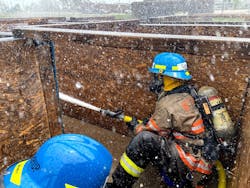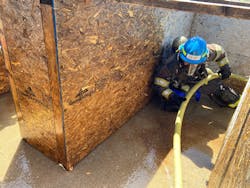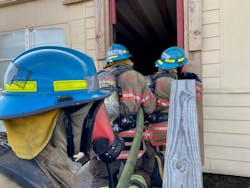Many of us teach our fire service kids the wrong way. The future of this profession, to which many of us passionately dedicate our life, relies on every single one of us passing on the lessons that are written in blood.
Many of us also were brought up on a method of instructing by which the participant feels more like a combatant than a student. Sometimes, this is described by instructors as a “rite of passage.” They survived it, so, now, the next generation must survive it, too.
Although I feel no need for my students or recruits to have “buy in,” I find skill retention and overall effort is greater when the lesson has some meaning and background. My preferred method of instruction is “crawl-walk-run,” because I believe that it creates small “wins” along the way while repeating the core skills that are the building blocks of this profession. I was able to incorporate this method into every aspect of recruit training to develop recruits who demonstrate excellent firefighter acumen on the drill ground and, more importantly, on the fireground. To demonstrate how a drill is put together using the crawl-walk-run method of instruction, I will use the example of a basic hoseline advancing drill.
The crawl phase
The crawl phase is where we start to build the muscle memory and confidence in the skill in firefighters. This should begin with as few distractors as possible to ensure that the basic foundations are put into place. As we progress, we add distractors, such as fatigue and mental stress, to hone the skills to work in the real world.
In regard to the basic hose drill, during the crawl phase, we use the minimum safety gear of gloves, helmet and safety glasses.
We stretch the lines on the ground with the nozzle and coupling next to each other and the working line in a big U shape. We go over proper nozzle technique, such as bale at arm’s length; exaggerated nozzle movements, with water covering the floor/ceiling and both walls; and handling kinks between the pinning area of hose and the nozzle, by envisioning that the hoseline is a broomstick between the hands when working the nozzle.
Some of the students will have experience. Tell them that if they are a “clamp slider” that they should practice the “hip pin” and vice versa. Most firefighters become comfortable with one style, but, invariably, at times, they must use another.
Newer members fight the nozzle. Keep an instructor beside them ready to assist.
We go over the backup position and how to move the line as a team, covering common engine company emergencies, such as fire wrap and holes in the floor.
Finally, we cover the door position and how to keep a bend in the line. In the circumstance of some groups, you can have all of the students comfortable in just a couple hours’ time. For other groups, all of this might take multiple sessions.
It’s important to take regular breaks and, after a couple of hours, to move on to another topic or skill and come back until the members can comfortably flow and advance line in all three positions: nozzleman, backup, door. Remember, during the crawl phase—as well as the walk phase— goals should be achievable and students “win” as long as they follow the techniques and listen to feedback.
The walk phase is where we start to add distractors for more realism. This can be done either one at a time or in unison. We add the appropriate gear, including full PPE and SCBA, which in and of themselves can be enough of a distractor. Unlike the crawl phase, we often come back to the walk-phase skills throughout our career, because they often are considered the bread-and-butter skills of our profession.
The walk phase begins with a quick review of the crawl skills with the addition of full PPE and SCBA, because the firefighters’ center of gravity changes, which necessitates some tweaking of technique. Following this, we usually move onto the training prop. (See “The ‘Newby Box’” sidebar.) A group of three must advance through the prop, which reinforces the skills of the three positions that were taught earlier and punishes bad technique. For the nozzle position, students must flow for two seconds at every corner, covering all prop surfaces.
Because there are 90-degree bends in both directions inside of the prop, the students must flow with the line away from the wall as well as against the wall.
Because most understaffed engines don’t have the backup immediately behind the nozzle, nozzle operators can set their SCBA bottle into the corners to help with nozzle reaction. By the second corner, if the backup firefighter is behind the nozzle, that individual must drop back a few feet to help with pinch points to facilitate the advance. The backup, and later the door position, must keep a bow in the line or keep the line pushed up on the wall to allow a smooth advance. At times, they will feel themselves getting between the wall and the line and must transition to the outside to keep from getting pinned.As the crew advances, the door position must start to move between the prop opening and the different corners. The 180-degree bend—along with the 90-degree bends—means that all members must work together to keep the line advancing and the nozzle working.
When the nozzle gets to the exit of the prop, the door position moves back to the opening and brings a 10-foot wheel of hose to the nozzle to allow for the advance from the simulated doorway of the fireroom to the back of the room approximately 10 feet away.
The run phase
Even in the run phase, all scenarios should be winnable—but only if everything is done correctly. If a crew fails to win, the members should be coached and put back in to redeem themselves as soon as possible.
Distractors here should be aimed at making the scenario as realistic as possible (i.e., background noise, pre-scenario physical exertion, time constraints, blackout masks, smoke and live fire).During this phase, you will see crews use shortcuts that many firefighters who are proficient at a skill will adopt. Although this isn’t to be discouraged, this is why we often return to the walk phase, so core skills are maintained.
For our hose drill, we put blackout masks on the crews that are going through the Newby prop. We add loud background noise to limit communication, which forces the crews to feel what the hose actually is doing in their hands.
We have them do burpees or advance the line off of the rig to the door and mask up while making note of shapes or colors that are taped to the walls. The goal is to stretch their mental bandwidth, so the skills that they perform are done without them thinking about them. The intent is to increase the information that they can take to the fireground without thinking about the rudimentary skills that are necessary to complete their task. Typically, once they are proficient at these things, we move to an acquired furnished trailer house on our training grounds. We give them a location of fire from their 360 size-up, and they stretch, mask up and advance to the fire with blackout masks in their facepieces. We change furniture locations and pile toys and soft objects along their path of advance.
Lay it out
The crawl-walk-run method can be used for almost every firefighter training drill, from ladders to hoselines, from basic search to down firefighter rescue. The easiest way to start is to write down what the goal of the training is, beginning with the simplest way to teach it and adding some distractors, until you finally have proficiency. After running a couple of drills and making adjustments to your teaching plan, you will have a solid strategy to educate your members and a good idea of the time that’s involved for each skill.
Providing the ‘Why’
There are many types of learners, so before beginning the instruction of recruits, it can be beneficial to explain to students the history and background of the drill that’s about to be taught. Perhaps most importantly, this provides the “why” for those students who are best off with that information.
In regard to a hoseline drill, the author often talks about the proud engine company culture in the Wichita, KS, Fire Department and shows fireground footage of crews stretching on working fires, with a timer running in the background. It’s emphasized how, for the nozzleman, getting the line in place is the single biggest life-saving action that will be done for civilians and fellow firefighters.
The ‘Newby Box’
The Newby box is a simple training prop that was conceived by Wichita, KS, Fire Department Battalion Chief Sid Newby (ret.). It hones the basics of nozzle skills.
The Newby box easily can be built out of two-by-fours and 4-by-8-foot sheathing. (It comes apart just as easily for storage.)
For water mapping, you can make the box more elaborate, but it must be long enough to separate out the firefighters and must have a couple of right and left 90-degree turns and a 180-degree bend.
About the Author

Keith Niemann
Keith Niemann is a 20-plus-year veteran of the fire service with Wichita, KS, Fire Department's training division, assigned to Firehouse 22. As a field training officer, Niemann responds to all fires and major alarms on his shift as well as serves as a lead instructor, teaching hands-on skills to members of all ranks. He also is the president of the FOOLS of OZ, teaching engine company operations throughout the country.



